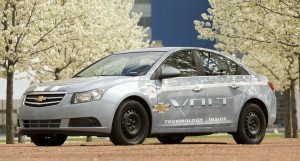November of 2010 will see the start of series production for the Chevrolet Volt, GM’s extended range electric vehicle. Volt is in essence a more practical — and just as expensive — evolution of the late Saturn EV1, with a 1.4-liter gasoline engine aboard to recharge the batteries after the initial 40-mile charge runs flat.
In simple terms, an electric vehicle without this onboard recharging capacity leaves your driveway with about the same range as you current car when the gas gauge reads, err, empty.
In a wide ranging discussion with Bill Wallace, Engineering Group Manager, VoltecBattery Systems, (GM’s brand name for the Korean-supplied lithium batteries from LG Chem) and Andrew Farah, Volt Vehicle Chief Engineer, I learned that the program for the small four-seat car is on track and that irreversible production decisions are now being locked in.
One critical decision involves the final chemical composition of the lithium ion batteries. With 300 of these hand-built batteries packs now undergoing testing, the exact lithium manganese polymer recipe is now set.
This final recipe came after four iterations of chemistry experiments that are a high stakes version of what you might have conducted in high school, only here to eke out 40 miles on a charge, and – critically — to provide ten year’s of life. As always, the issue on battery life is heat. You do not want to park any battery vehicle at Sky Harbor airport in Phoenix for the summer while vacationing in Alaska. The result will be hard on warranty costs.
The Volt’s batteries are meeting energy power requirements, according to Wallace, and the team is now balancing issues such as safety, regulations and customer satisfaction with other concerns such as performance, durability, packaging and vehicle design.
What isn’t locked in is the unknown curb weight of the Volt or its 200-kilogram battery pack. In order to exact the maximum performance, ala Newton, (F= MA for those of us many model years away from physics 101), an ongoing diet is underway.
Other issues involve noise. Since the vehicle is so quiet, the development team is working on ways to reduce ambient noise when the vehicle is in motion. Standard bushings are being replaced with hydraulic ones. Engine noise is being closely tended to with additional insulation under consideration since the engine starts after 40 miles to recharge the batteries or anytime the controller thinks the batteries need zapping.
Eighty pre-production Volts have been built. There have been more than 250,000 miles of testing on the pre-production and mule vehicles. Some of the highlights of this testing include hot weather testing in Death Valley, mountain testing at Pikes Peak.
The Detroit-Hamtramck Cadillac plant where Volt will be assembled is in the process of being retooled. New equipment is now moving in. The next build of Volts comes at the end of March in the plant.
“This is just as we planned,” Farah said. “We’re on schedule to start regular production of the Chevrolet Volt almost exactly one year from now — late 2010. And we’re on time because we are confident with the various program development tests we’ve been conducting this year.”

